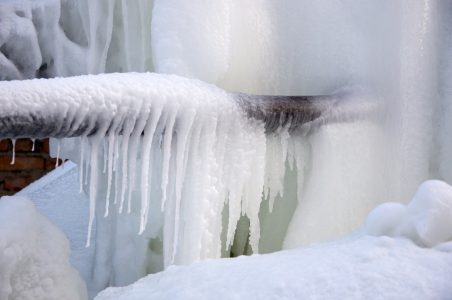Avoid Frozen Pipes in Winter: Expert Advice
Avoid Frozen Pipes in Winter: Expert Advice
Blog Article
Have you been hunting for additional info about Winter Plumbing Precautions: Preventing Frozen Pipes?

Winter can wreak havoc on your pipes, especially by freezing pipelines. Right here's exactly how to prevent it from taking place and what to do if it does.
Introduction
As temperature levels drop, the danger of icy pipelines boosts, possibly resulting in pricey repair work and water damages. Comprehending just how to prevent frozen pipelines is crucial for property owners in chilly environments.
Avoidance Tips
Insulating prone pipelines
Cover pipes in insulation sleeves or utilize warmth tape to protect them from freezing temperatures. Focus on pipes in unheated or outside locations of the home.
Home heating strategies
Maintain indoor rooms properly heated up, particularly areas with plumbing. Open cabinet doors to allow warm air to distribute around pipes under sinks.
How to identify icy pipelines
Try to find lowered water circulation from faucets, unusual odors or sounds from pipelines, and noticeable frost on subjected pipes.
Long-Term Solutions
Architectural modifications
Think about rerouting pipes far from outside walls or unheated locations. Add additional insulation to attics, basements, and crawl spaces.
Updating insulation
Purchase high-grade insulation for pipes, attics, and wall surfaces. Proper insulation helps preserve constant temperature levels and lowers the risk of frozen pipes.
Safeguarding Outdoor Pipes
Garden hoses and outdoor taps
Detach and drain pipes garden pipes before winter season. Set up frost-proof faucets or cover exterior faucets with shielded caps.
Understanding Frozen Pipelines
What creates pipes to freeze?
Pipes ice up when exposed to temperature levels listed below 32 ° F (0 ° C) for expanded periods. As water inside the pipes freezes, it expands, putting pressure on the pipe walls and potentially triggering them to rupture.
Risks and problems
Icy pipes can result in water system disruptions, residential property damages, and pricey repairs. Ruptured pipelines can flooding homes and trigger considerable architectural damages.
Indications of Frozen Water Lines
Determining icy pipes early can prevent them from rupturing.
What to Do If Your Pipes Freeze
Immediate actions to take
If you presume frozen pipelines, keep taps available to ease pressure as the ice thaws. Utilize a hairdryer or towels taken in hot water to thaw pipelines slowly.
Verdict
Avoiding icy pipes calls for aggressive steps and fast feedbacks. By recognizing the reasons, indicators, and preventive measures, homeowners can secure their pipes during cold weather.
6 Proven Ways to Prevent Frozen Pipes and Protect Your Home
Disconnect and Drain Garden Hoses
Before winter arrives, start by disconnecting your garden hoses and draining any remaining water. Close the shut-off valves that supply outdoor hose bibs and leave the outdoor faucet open to allow any residual water to drain. For extra protection, consider using faucet covers throughout the colder months. It’s also important to drain water from any sprinkler supply lines following the manufacturer’s directions.
Insulate Exposed Pipes
Insulating your pipes is an effective way to prevent freezing. Pipe insulation is readily available at home improvement stores and is relatively inexpensive. Pay close attention to pipes in unheated areas such as the attic, basement, crawl spaces, or garage. Apply foam insulation generously to create a buffer against the cold. You can also wrap your pipes in heat tape or thermostat-controlled heat cables for added warmth.
Seal Air Leaks
Inspect your home for any cracks or openings that could let in cold air. Seal any holes around the piping in interior or exterior walls, as well as the sill plates where your home rests on its foundation. Additionally, make sure to keep your garage door closed unless you’re entering or exiting. Leaving it open creates a significant air leak that can lead to frozen pipes.
Allow Warm Air Circulation
During cold snaps, it’s essential to allow warm air to circulate evenly throughout your home. Leave interior doors ajar to promote better airflow. Open kitchen and bathroom cabinets to help distribute heat consistently around the rooms. If you have small children or pets, be sure to remove any household chemicals or potentially harmful cleaners from open cabinets for safety.
Let Faucets Drip
A small trickle of water can make a big difference in preventing ice formation inside your pipes. When temperatures drop significantly, start a drip of water from all faucets served by exposed pipes. This continuous flow helps prevent the water from freezing. Additionally, running a few faucets slightly can relieve pressure inside the pipes, reducing the chances of a rupture if the water inside does freeze.
https://choateshvac.com/6-proven-ways-to-prevent-frozen-pipes-and-protect-your-home/

Do you appreciate reading about Preventing and dealing with frozen pipes? Create feedback down below. We'd be happy to listen to your opinion about this write-up. We hope that you come back again later on. I beg you take a moment to promote this blog entry if you appreciated it. Thanks so much for going through it.
Click Here Report this page